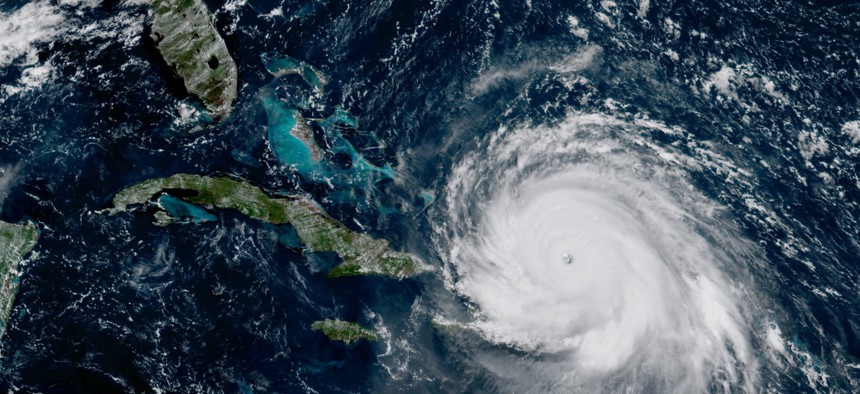As Irma Advances on Florida, County Leaders Prepare for the Worst and Hope for the Best

NOAA-NASA via AP In this geocolor GOES-16 satellite image taken Thursday, Sep. 7, 2017, at 11:15 a.m. EDT, shows the eye Hurricane Irma just north of the island of Hispaniola.
“We are much better positioned as a county today to respond to these types of events than we ever have been,” Pinellas County’s assistant administrator said amid the preparations.
ORLANDO — When Hurricane Hermine threatened Tampa Bay on Florida’s Gulf Coast in 2016, Pinellas County distributed tens of thousands of sandbags to help its citizens fortify against the Category 1 storm. As Hurricane Irma, the strongest Atlantic storm ever recorded, barrels toward the Sunshine State, the county has handed more than 100,000 sandbags since Tuesday and has hundreds of tons more ordered to meet demand.
The sandbag operation is just one of the many ways county officials have been preparing for impacts of the Category 5 hurricane, Assistant County Administrator John Bennett explained at an impromptu Pinellas County Commission meeting Thursday morning.
“We started putting our preparedness messaging out long before we opened up a sandbag,” he said, explaining that the first couple weeks of September are “peak” hurricane season and the county had ramped up its messaging around Labor Day.
By Tuesday evening, Pinellas County, a 280-square-mile peninsula nestled snugly between the Gulf of Mexico on the west and Tampa Bay on the east, transitioned to an “evacuation preparedness message” and on Thursday began issuing mandatory evacuation orders for low-lying areas along the beaches and for those who live in mobile home communities.
Residents living in higher level B and C flood zones could face evacuations as early as Saturday morning, before officials get a true sense of what ultimate path Irma will take. While the spaghetti forecast track models earlier in the week predicted that Irma would potentially take a slight jog to the right, taking it over South Florida and up along Florida’s Atlantic coast, more recent models suggested the dangerous storm will likely move directly up the spine of the state.
A third, more westerly track, could take Irma directly over Tampa Bay, but confidence in the storm’s ultimate path will likely not be clear until some time between noon and midnight Saturday, when the storm either makes a turn eastward, or doesn’t. Waiting until that happens wouldn’t provide enough time for safe evacuations, Pinellas County Administrator Mark Woodard, explained, so the county is erring on the side of caution.
If the forecasted turn to the north happens, Woodard told commissioners, at that point they could “downgrade” or “deescalate” evacuations, but until then, the county should “prepare for the worst, and hope for the best.”
With close to 950,000 residents, Pinellas is one of the most densely populated counties in Florida, and it’s also one of the most vulnerable to flooding and damage from a hurricane. A recent eye-opening feature by The Washington Post spelled out the potential for calamity in the Tampa Bay region, noting that a direct hit would likely cause more damage than Hurricane Katrina.
It’s not just the beach areas along the Gulf Mexico that are susceptible to flooding. Neighborhoods like Shore Acres on the east side of the peninsula regularly flood during heavy rains and residents of Snell Isle, which juts out into the bay from the edge of downtown St. Petersburg, often find themselves stranded when storms put the only bridge leading in and out of their neighborhood under water.
The Tampa Bay region has been relatively lucky in recent years when it comes to storms.
The last time a major hurricane hit the Tampa Bay area was in 1921 , before storms had human names. That storm killed eight people and did about $10 million worth of damage.
And while it looked like the area’s luck had run out in 2004, when Hurricane Charley was headed straight for Tampa Bay, the Category 4 storm took an unexpected turn to the east and ripped through Punta Gorda, 91 miles south of St. Petersburg, and then shredded its way through Central Florida.
Charley, which was one of several storms impacting Florida during the busy 2004-05 hurricane season, ultimately caused $13 billion in damage and resulted in 29 fatalities in the Sunshine State. But on the heels of that storm, and Hurricane Katrina, county officials decided to make critical improvements to their disaster management operations.
Among the lessons learned from Katrina: It doesn’t matter how many emergency responders and emergency vehicles you have if they’re not stored in a safe facility.
With that 20-20 hindsight, Pinellas County has since built two emergency response facilities in different parts of the county that include secure vehicle storage. Both buildings are designed to withstand a Category 5 storm.
“We are much better positioned as a county today to respond to these types of events than we ever have been,” Woodard said.
In disasters, smaller details can also s make a big difference. Knowing that some residents may refuse to evacuate if they cannot take their pets, Doug Brightwell, field services manager for Pinellas County Animal Services, ordered portable pet crates for first responders to have on hand as they evacuate the county’s special-needs population.
As for the three-hour waits for sandbags and long gas lines that many residents have been encountering over the past couple of days, officials took it as a good sign. “Because of the Harvey effect, everyone is making sure they are fully prepared,” Bennett told commissioners.
Amy Keller is a journalist based in Orlando.

NEXT STORY: Governors Back Bipartisan Senate Plan to Stabilize Health Markets





